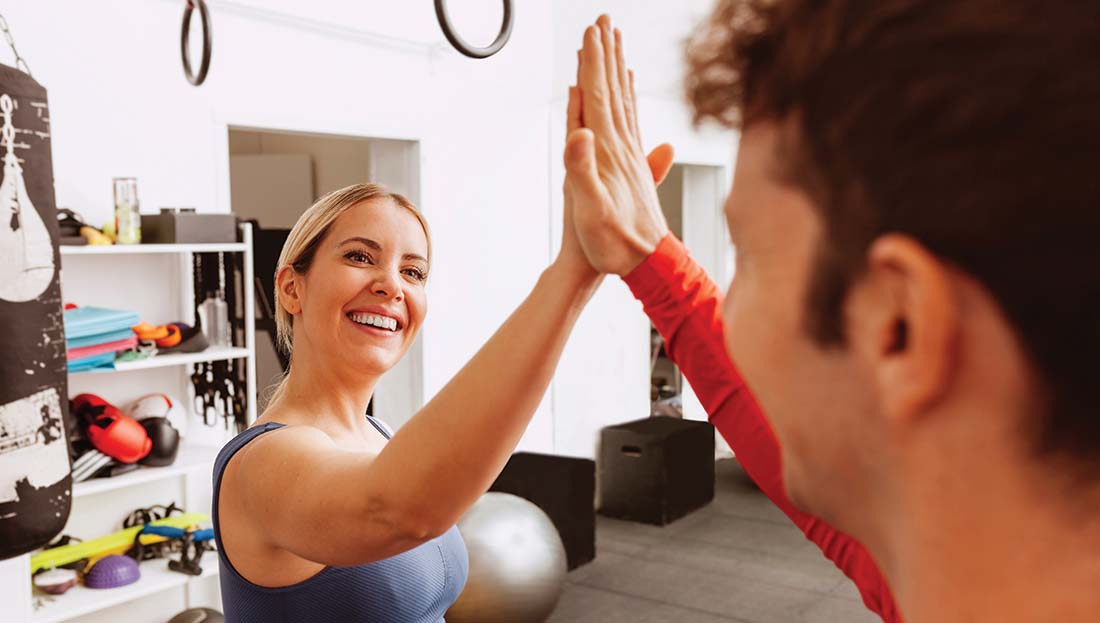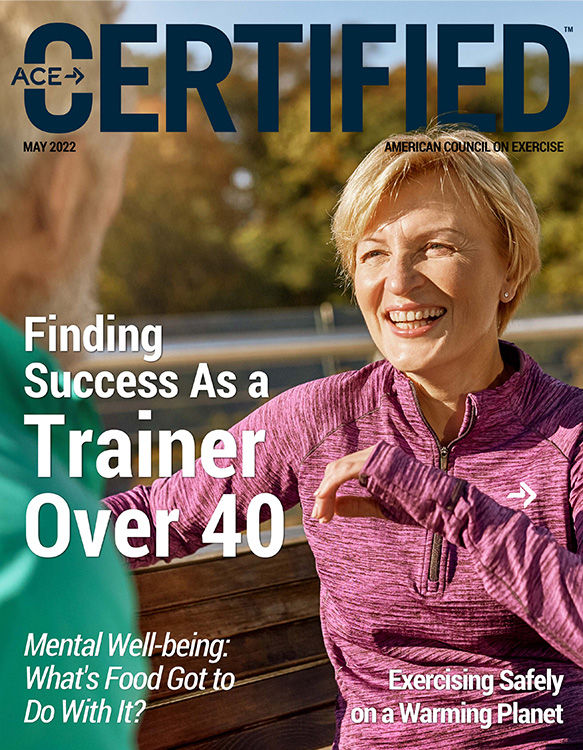
For Norma Saulino, a training regimen provided stability and renewed self-confidence during a turbulent time in her life. But it also provided the impetus for a mid-life pivot into a new career—as a personal trainer.
In 2013, Saulino’s son had just gone off to college. Her marriage was dissolving. She had sold the condo in Manhattan that she could no longer afford, because she had been laid off from her job in magazine publishing, where she had previously enjoyed a successful career as an executive with a number of major media corporations.
She was unhappy about herself—and her life. She moved back to her native New Jersey to live with her sister, who encouraged Norma to get back into the exercise regimen that had helped her lose weight years before.
“My sister mentioned that she had seen a group of people working out in a local park,” recalls Saulino, now 63. “‘You should check it out,’ she said. So just to have something to do, I showed up.”
Although she was the oldest participant in the Boot Camp group that met at Hamilton Park in Jersey City, she impressed the young trainer with her determination and tenacity—not to mention the results she managed to achieve over the coming weeks. “I lost weight, I was getting really strong and had added some definition,” says Saulino. “My sister said, ‘Your body has completely changed!’”
But it wasn’t just her physique that was in a transformative state. Saulino found herself fascinated and immersed in the training environment and the camaraderie of the group. “I absolutely loved it,” she says.
No doubt the well-spoken Saulino impressed the group as well, because, as she explains it, "the trainer, a guy named Nick, out of the blue said to me, ‘Why don’t you go into personal training?’”
The idea struck her like a thunderbolt. “I hadn’t been considering it, but once he mentioned the idea, I began thinking.” She needed a new direction in life. She had personally experienced the benefits of a healthy, fit lifestyle. The more she considered it, the more it seemed to make sense. “I said to myself, ‘You know what, I have nothing to lose?’”
She knew she would need to get credentialed, and her trainer suggested ACE. And so, for the first time since college, Saulino found herself studying for an exam. She earned her ACE certification—and several more later—but also managed to land something else: A position as an entry-level trainer at Equinox in Manhattan.
“The first month, I worked seven days a week," she says. “To start, I was handing out towels, working the floor, helping to organize equipment in the gym. And getting minimum wage. It was a tough way to make a living.”
Tips for Trainers of a Certain Age (From Trainers of a Certain Age)
- Use what you know. “If you had a corporate career that required sales and marketing skills, that’s a big leg up,” says Saulino. “Being comfortable cold calling potential clients, setting up sessions, maintaining systems like templates of existing clients’ programs, and scheduling to maximize your working hours all play a role. This also helped me a lot when I became an independent trainer. Being able to look back at what a client did a month prior and telling them how many reps they’ve increased, or how mobility has improved, or how much more weight they are able to handle now can be a great motivator.”
- Learn what you don't know—especially the fitness tech. Know how a heart monitor works. Learn how to adroitly raise the elevation or speed on a treadmill. Make sure you’re capable of quickly and smoothly adjusting weights and machines. “Most younger people have a seamless relationship with technology,” says communications coach and consultant Raleigh Mayer, a/k/a The Gravitas Guru. “You don’t want to be asking for their help with everything.”
- Mine your life experience… Your personal setbacks, whether from life experience or health issues or injury, are all opportunities to learn, grow and apply to how to help others. “Do research constantly and never stop learning,” says Saulino. “There is a ton of health and fitness information out there—learn to suss out reliable, well-researched data, don’t get wedded to any single approach and build your own style. The more you read, listen to and try for yourself, the more savvy you will become.”
- …but don’t make your age a theme or a constant refrain. Be careful about reinforcing the age difference. Mayer, who teaches leadership and communication to graduate students at Columbia University’s Fu Foundation School of Engineering and Applied Science, recommends avoiding sentences that start with “When I was your age…” or “Back in the eighties….” You want to be on a peer level with your clients as much as possible—more of a friend than a parent. “If you continue to point out that you’re not chronologically aligned, it might be uncomfortable.” Moreover, Mayer says, “don’t whine or harp about age. You’re not a geriatrician, you’re a trainer, so you want to avoid commiserating on physical issues and limitations. Because your job is to improve their mobility and expand their physical fitness, not to validate all of their physical ailments, as real as those might be.”
Especially for someone then in her mid-50s.
She soon realized, however, that being one of the oldest trainers at the then-new Equinox club in Brookfield Place in lower Manhattan had its advantages in terms of building a client base. “I developed a special connection with professional women,” she explains, “because I had walked in their shoes. I knew what it was like to be a working mother, trying to stay in shape while raising your children, and travelling and having the pressure of a big presentation coming up. How hard should you push in the gym when you’re juggling all that? How much rest do you need? I was able to tap into that and help them meet their goals. Some of them just needed to reduce stress, and I understood, that as well.”
Someone to Relate To
In other words, Saulino was able to relate to these women, and them to her, in ways that someone in other stages of life might not have been able to. Even in a profession synonymous with youth, age can sometimes be an asset not a liability—particularly as the gym population grows older.
“Older trainers tend to listen more to their clients and what they need,” asserts trainer and group fitness instructor Leigh Anne Bolling Richards, who was general manager of a health club in Montgomery, Alabama, and teaches wellness at Auburn University-Montgomery. “My experience with younger trainers is that they often feel they have to incorporate everything they’ve learned. They want to do with their clients what they think the clients should be doing.”
Older trainers, by contrast, are more likely to pay attention to older clients’ reservations and limitations. They’re also more likely to understand the Boomer-ish penchant for questioning authority, whether it’s in Washington, D.C. or the person they’re paying to lead them through a workout.
“Older clients are going to be more inclined to ask why you’re having them do 15 burpees,’ says Bolling Richards, with a chuckle. “I think older trainers are going to be a little more patient in that sense. They’ll take the time to explain the purpose.”
Insight, Empathy and Understanding
It’s safe to say that younger health and exercise professionals have a host of advantages and benefits that contribute to their success—energy, enthusiasm, commitment and perhaps fewer aches and pains than their older counterparts, to name a few. However, older trainers also bring something that their clients, particularly those who might also be north of 40, might appreciate: Understanding—and perhaps greater insight into the barriers faced by older clients trying to get in shape.
After a career as a United States Naval officer and a stint working in the defense industry, Lawrence Indiviglia found his Act 3 in something he had been involved with all his life: fitness. Now a coach with Todd Durkin Enterprises, Indiviglia—now in his mid-60s—has learned that he can offer something to his clients that even the most well-intentioned young trainer cannot: life experience.
“As an older trainer, you have empathy,” explains Indiviglia. “You have walked through life’s journey, and experienced the ups and downs, the wins and losses that perhaps someone who is younger has not experienced.”
Indiviglia offers this example: “When one of my clients says, ‘Larry, I’ve had back pain,’ I can empathize. That’s really, really important. I can say to that client with back pain, ‘I’ve had it, too. And I was able to minimize that pain by doing the same things I’m going to show you.’ A good younger trainer can certainly show that client those same things, but it may be harder to relate if they haven’t experienced what the client is going through.”
Finally, older trainers can also serve as fantastic role models by altering our sense of what it means to grow older, and demonstrating the flexibility and resilience that’s needed to adjust to new realities (something the recent pandemic forced all of us to contend with). Saulino has found that a later-in-life career in fitness rejuvenated her in every sense. Now living with a new partner in Lanoka Harbor on the Jersey shore, she successfully made the transition to online training during the pandemic. She has a dedicated roster of clients, and a still-burning passion for her later-in-life career in personal training. “I absolutely love it,” Saulino says. “I'm so happy I did this. I feel like I'm living my best life.”





 by
by 


